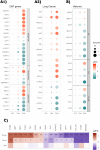Long-Term Exposure to Real-Life Polyethylene Terephthalate Nanoplastics Induces Carcinogenesis In Vitro
- PMID: 40452141
- PMCID: PMC12164274
- DOI: 10.1021/acs.est.5c01628
Long-Term Exposure to Real-Life Polyethylene Terephthalate Nanoplastics Induces Carcinogenesis In Vitro
Abstract
Micro/nanoplastics (MNPLs) are environmental contaminants originating mainly from plastic waste degradation that pose potential health risks. Inhalation is a major exposure route, as evidenced by their detection in human lungs, with polyethylene terephthalate (PET) among the most abundant particles in respiratory airways. However, the harmful effects of particle bioaccumulation remain unclear, as chronic effects are understudied. To assess long-term effects, specifically carcinogenic effects, BEAS-2B cells were exposed to PET-NPLs for 30 weeks. Genotoxicity, carcinogenic phenotypic hallmarks, and a panel of genes and pathways associated with cell transformation and lung cancer were examined and compared across three exposure durations. No significant effects were observed after 24 h or 15 weeks of exposure. However, a 30-week exposure led to increased genotoxic damage, anchorage-independent growth, and invasive potential. Transcriptomic analysis showed the upregulation of several oncogenes and lung cancer-associated genes at the end of the exposure. Further analysis revealed an increase in differentially expressed genes over time and a temporal gradient of lung cancer-related genes. Altogether, the data suggest PET-NPLs' potential carcinogenicity after extended exposure, highlighting serious long-term health risks of MNPLs. Assessing their carcinogenic risks under chronic scenarios of exposure is crucial to addressing knowledge gaps and eventually developing preventive policies.
Keywords: carcinogenicity; chronic exposure; human health risk; nanoplastics (NPLs); new approach methodologies (NAMs); polyethylene terephthalate (PET); respiratory toxicity.
Figures






References
-
- Plastics Europe. Plastics – the fast Facts 2023. accessed October 30, 2024. https://plasticseurope.org/knowledge-hub/plastics-the-fast-facts-2023/.
-
- García-Rodríguez A., Gutiérrez J., Villacorta A., Arribas Arranz J., Romero-Andrada I., Lacoma A., Marcos R., Hernández A., Rubio L.. Polylactic acid nanoplastics (PLA-NPLs) induce adverse effects on an in vitro model of the human lung epithelium: The Calu-3 air-liquid interface (ALI) barrier. J. Hazard. Mater. 2024;475:134900. doi: 10.1016/j.jhazmat.2024.134900. - DOI - PubMed
MeSH terms
Substances
LinkOut - more resources
Full Text Sources

